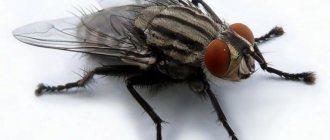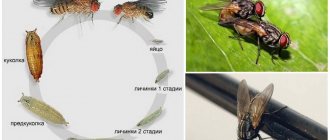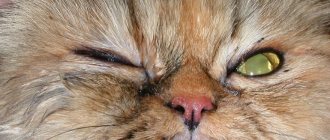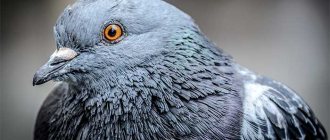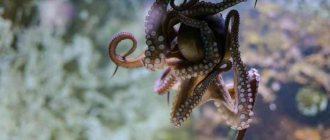general information
A fly is an insect of the order Diptera, a type of arthropod.
Some of them are eaten by other animals (birds, frogs, predatory insects). Others are predators themselves and regulate the numbers of numerous insects. And also among them there are parasites (bloodsuckers) of animals or humans.
They can hover in the air, fly backwards, or fly upside down. Their reaction is 10 times greater than that of humans. Some species have viviparity, although most individuals are characterized by oviparity.
The size of an adult housefly reaches 0.6-0.8 cm. The weight of flies ranges from 0.12 g to 32 g (African fly). They live on all continents, except in Antarctica.
Why is an insect dangerous?
Most often, people have to deal with houseflies. It is advisable to do this, since it is a mechanical carrier of pathogens of dangerous diseases.
Regardless of how long the pest lives, it can provoke the following pathologies in humans:
- intestinal infections;
- tuberculosis;
- ophthalmological diseases;
- helminthiasis;
- intestinal myiasis.
Light flies are active blood-sucking insects that live mainly in areas where there are domestic animals, especially cattle.
Once in residential areas, these parasites often bite people or pets.
Zhigalka carries the following diseases:
- anthrax;
- sepsis;
- tularemia;
- staphylococcal infection.
Infection occurs as follows: after contact with a sick individual, the burners rush to the next victim and, during the bite, inject pathological saliva into the wound.
The Tsetse fly is considered the most dangerous in the world. After the bite of this insect, the human immune system is first affected, then the process affects the nerve endings. A swelling appears at the site of the bite.
The victim experiences lethargy, drowsiness, and apathy.
The disease develops over 3-4 months. If the patient is not provided with proper assistance, everything will end in death.
External structure
At first glance, the structure of a fly seems simple. But if you delve into how many features this living organism has, it becomes obvious that not everything is so simple.
The skeleton of a fly consists of three main parts, like those of most insects:
- head;
- breast;
- abdomen.
The head of the pest has a mouthparts, antennae, and a vision organ. The chest is equipped with three segments with a pair of transparent wings, and there are also 3 pairs of limbs on it. The chest part is filled with a powerful muscular system.
The abdomen contains the main part of the digestive and reproductive organs. Also of interest is how many legs a fly has.
Fly head
Entomologists know how many eyes an ordinary fly has, as well as other features of the organs of vision and touch that the fly’s head is endowed with:
- Eyes. The organ of vision of a buzzing parasite consists of a large number of simple ocelli. Visually, this represents a faceted grid. The pest sees objects comprehensively, but their image turns out to be mosaic. Each facet sees a small fragment, and they are all combined into a single picture by the brain. Each organ of vision, located on the sides of the head, includes up to 4000 facets. And on the crown there are also 3 simple eyes. It turns out that the fly has only 5 eyes.
- Mustache. This is a kind of olfactory organ of the pest. They are antennas or movable jointed appendages of the head that serve as landmarks. The antennae help in capturing odors at long distances and also determine the direction of movement. The antennae of females and males are visually different.
- Oral apparatus. It is a sucking proboscis of a fly, of the licking type. The extended lobes of the upper and lower lips come into contact with food. The pest's jaws are powerful. The mouthparts of the parasite, which feeds on blood, are additionally equipped with hard, sharp scales. They perform the function of teeth, helping to pierce the skin of humans or animals. To draw in fluid, the parasite has a pharyngeal pump.
Males and females are distinguished by how many visual elements the pest has.
There are more of them in the male sex, and the female has a better developed olfactory system, with the help of which she finds favorable conditions for laying eggs and for the further development of offspring.
Breast
The thorax or thorax is distinguished in all segmented invertebrates. In buzzing parasites it is divided into 3 segments. Bone structures and muscle fibers allow flight, so the middle part of the chest is especially developed.
When considering this section, it becomes clear how many legs such creatures have. Entomologists distinguish 3 pairs of limbs. Each is divided into 5 segments and equipped with its own muscle system.
Each paw ends with claws and suction cups, allowing the parasite to confidently hold on to any surface, even the most uncomfortable.
When moving, the soft pads compress and a sticky secretion is released. This feature helps them hold and move freely on window glass or a smooth surface.
With the help of its paws, the parasite not only actively moves, but also uses it to determine the taste and quality of food. After a few seconds of analysis, he starts eating or looks for a new treat.
Wings of a fly
Entomologists know how many wings such a parasite has. They explain that only the upper wings of the fly are preserved and they are well developed. This exoskeleton appendage is transparent and membranous. The posterior pair is deformed and forms halteres.
They provide support during flight, allow you to hover without moving for a while, and also produce a peculiar buzzing sound. To strengthen the thin wings, cylindrical veins are provided.
During the flight, the parasite turns off one of the wings one by one. It is capable of abruptly changing the trajectory of movement, performing complex maneuvers, and also abruptly taking off without additional acceleration.
This amazing structural feature was taken by scientists when developing many flying designs of airplanes or helicopters.
Abdomen
Also of interest is the abdomen and how many segments it contains. This part of the body is elongated, cylindrical in shape. Consists of 10 parts and also includes reproductive, respiratory and digestive organs.
The abdomen is covered with elastic chitin, which increases with food intake and before eggs are laid. How much a parasite weighs constantly changes depending on its condition.
Nutrition
The house fly is diurnal and quiets down at dusk. During daylight hours, it searches for food and lays eggs. The house fly is a polyphage and feeds primarily on liquid food. Favorite dishes are fruit juices, jam, honey, syrup. In severe cases, when there is no other food, he eats sugar, cookies, bread crumbs, and candy.
The mouthparts are piercing-sucking, but cannot bite through human skin. House flies do not feed on blood; autumn flies do this. They are very similar in appearance, so a person does not feel the substitution. Unlike its domestic relatives, the oral apparatus is equipped with sharp scales that act as teeth and gnaw through the skin of humans and animals. Minor differences in appearance - the wings are spread out to the sides.
There is no digestive system as such. Digestion of food occurs externally. The same feature is present in the larvae. Initially, the insect sprays a special secretion - saliva, which liquefies the food. After which the housefly calmly sucks up the liquid product. Digesting solid food requires more effort, so insects do not like this food very much.
Internal structure
Having studied the internal structure of a fly, an ordinary person will make a lot of discoveries for himself. Entomologists know very well how many internal organs and systems this insect has, what their tasks are and how they function.
Reproductive system
The internal reproductive organs are abdominal. The male has testes, the female has eggs. The reproductive system also includes accessory glands and ducts. The external appendages differ in shape among different species.
In males, the expanded last segment bears special grips necessary to hold the female by the ovipositor during mating.
How many eggs the female lays at one time (70-150), depending on her species. Among blowflies (corpse flies) there are viviparous species.
The fertilized female finds a decomposing corpse and sits on it, touching the surface with her abdomen. After this, very mobile larvae instantly appear and quickly penetrate the tissue.
Digestive system
The abdomen contains most of the digestive organs: intestines, crop, excretory vessels. Inside, there is no digestive tract as such.
All food is digested externally with the help of a secretion secreted by the parasite. And into the expanded part of the esophagus, food arrives ready for absorption.
Other organs, systems
Additionally, parasites have the following systems:
- brain and nervous system. Everything is very simplified. The brain coordinates the behavior of the insect, but the reflex arc is responsible for the reflexes. The brain is very small, but has thousands of neurons. It allows the buzzing parasites to perform amazing feats while flying.
- Circulatory system. It is equipped with an aorta, pterygoid muscle, and dorsal vessel. There is also a heart, but it is very simplified and has little functionality. The blood is colorless or has a yellowish tint. It transports nutrients throughout the body, but does not saturate the body with oxygen, and also does not contain red blood cells.
- Respiratory system. The body of the pest is dotted with numerous tracheae, which branch into small capillaries with a complex structure. Opens outwards with spiracles. They carry oxygen directly to various organs and tissues. Entomologists know how many spiracles there are on the body, thanks to which flies breathe. They report that there are up to 10 pairs of such body elements. Of these, 8 are located on the abdomen, and 2 on the chest.
When danger appears, the nervous system and brain help the parasite change the direction of movement in the opposite direction in a matter of seconds.
Ktyri
Slender, predatory flies are quite large in size. The body and limbs are covered with a thick layer of short hairs. For humans, blackflies do not pose any danger, but insects such as mosquitoes, midges, beetles and even bees are quite rightly
they are afraid.
Ktyrs obtain food by hunting in the air, clutching the caught prey with their tenacious long paws. After this, they stick their sting into the defenseless body to inject poison into it and calmly suck out the contents. Sometimes another ktyr can become the prey of a ktyr.
This predatory fly brings great benefits to humanity, killing and eating many different dangerous insects. Ktyri are also predators. They live in rotten wood, soil and other rotting matter, where their food is various small insects and other larvae.
Life cycle
The life cycle of a fly has several stages. In them, like in many species of insects, the formation of an adult individual occurs in four stages:
- egg;
- larva;
- chrysalis;
- adult (imago).
Each adult female is capable of laying eggs 6-10 times throughout her life, and a clutch can contain from 50 to 150 eggs. The individual is capable of reproduction within a few days after emerging from the pupa.
Eggs and larvae
Leaving behind offspring is the main goal of all living organisms on the planet. And the housefly is no exception. But, as practice shows, the more developed a creature is, the fewer offspring it can produce during its lifetime.
Under favorable conditions, the fly begins to multiply rapidly
There is a hypothesis about the brain, the construction of which takes the most substances from the mother’s body. But since insects do not have high intelligence, their offspring can reach several thousand individuals.
This video talks about the dangers of house flies:
They lay their clutches in places where the hatched larva will not need to look for food. This is stale food or rotting garbage. It is very difficult for a person to detect the nest, since the size of one egg does not exceed 1.2 mm. The eggs are white and oblong in shape. The period of their full maturation takes no more than two days, after which the larvae appear.
The larvae of these winged insects are usually white and cone-shaped with a mouth cavity at the narrow end. They can grow up to 13 mm in length. They feed on the waste in which they were born and grow in size very quickly. People call them maggots and use them as bait for fish. Today, maggots are specially bred for sale in fishing stores. This bait should be stored in the refrigerator to slow down the pupation process, which usually occurs after 3 molts.
Formation of pupae
The maturation process of maggots can last from 3 to 25 days. It depends on the amount of food and the warm environment. Temperature conditions +25…+30°С are the most favorable for the rapid development of larvae. Having reached the desired size, the maggot crawls to a cool place and begins to form a pupa.
After passing through three stages of growth, the larva turns into an adult.
The pupa has the same shape and size as the larva. Fishermen also use cocoons as bait and call them caster. The shell gradually hardens and turns brown.
Usually, the larva remains in the form of a caster for about a week, then an adult emerges from it. But if climatic conditions are not favorable for birth, then the fly may delay its birth. The pupa can remain in this state for quite a long time. There are cases where this condition lasted for several years.
Emergence of an adult
After complete formation, the adult insect is born, and after three days it becomes capable of producing its own offspring. How long a common fly lives is influenced by factors such as:
- climatic conditions;
- concentration of harmful substances in the air (flies breathe through the skin);
- habitat.
The main period of activity is observed in the warm season; in cold seasons the fly hibernates
Typically, the lifespan of a common fly is about 30 days. If we add here two days as an egg, a period of 20-30 days for the larvae to mature and the time of pupation, it turns out that the complete life cycle of a fly is about 2.5-3 months.
But you need to make allowances for climate and environment, and also take into account the type of insect, because flies, like other living beings, are very different from each other.
About limbs
The legs of insects also raise many questions, from the most naive, how many legs does a fly have, to the rather serious and interesting ones. The fact that a fly, like other insects, has six legs is taught in school, but the question of why flies rub their legs, asked by a curious child, can confuse more than one dad.
It turns out that this is a standard hygienic procedure. Flies, flying from sewage to food, collect various debris on their legs and, naturally, get dirty. In order to clean their paws from the dirt stuck to them, flies wipe their paws one against the other, and thus clean themselves. First they rub their forelimbs, then they use them to clean the head, and then their hind limbs - the wings.
Now to the question of how the fly stays on the ceiling.
Many authors believe that insects cling to the smallest protrusions on the surface with hooks on their legs that are barely visible to the naked eye. But this is the wrong point of view; how else can we explain the tenacity of flies on completely flat surfaces, for example, glass.
It turns out that there is a very simple explanation for this phenomenon. The fact is that the protrusions on the legs of the fly are not hooks at all, but tiny capillaries. Through them, insects secrete a kind of sticky liquid onto the surface, which then holds their light body on a vertical or horizontal surface.
If a fly decides to launch from a ceiling or wall perpendicular to the surface, like a rocket, then the tensile force generated by this adhesive composition will not allow them to do this. Therefore, insects are forced to take off tangentially, similar to an intercontinental airliner.
About brains
Now let's think about this topic: does a fly have a brain? It would seem, why does such a small creature need it? However, in the head of an insect there are about three hundred thousand neurons, which, of course, is nothing compared to our twenty billion such cells, but still
This number of active cells is enough for a small creature to be active and fulfill its most urgent needs.
About the eyes
Looking at the eyes of a fly, many wonder about their vision. In fact, we do not see the usual proteins and pupils inherent in mammals, and often we cannot understand how a fly sees.
In fact, they, like many other insects, have so-called “faceted” vision. The eye consists of many tiny sectors. each of which is responsible for displaying a small area of space. Then the tiny fly brain, discussed in the previous chapter, puts the pieces of information together, and the fly represents the whole picture around it.
This eye arrangement allows the fly to see a 360-degree image, and in color. And the optimal frame rate for her is not 24 per second, like a human’s, but as much as 300.
About the heart
Does a fly have a heart, and in which egg is hidden the needle that will kill it like the famous Koshchei?
In the same sense as humans, flies are heartless. But still, the organ that moves their blood through a single straight artery also exists in these insects.
This phenomenon is explained by the fact that, unlike mammals, the blood of insects does not carry out the function of delivering oxygen to the most important parts of the body. Roughly speaking, flies breathe through their skin, not their lungs.
About a fly's dream
The interesting question of whether flies sleep shocked even scientists. Regardless of the structure of the brain, insects are also forced to rest. Moreover, it was found that young flies that have just emerged from the pupa sleep more soundly and longer than their relatives who have lived for a couple of weeks. Tests have even shown that coffee has the same stimulating effect on these insects as it does on humans due to its antihistamine properties.
Stages of development
Most insects are characterized by developmental metamorphosis in several stages. The fly is no exception. In the life of this insect, all the traditional four stages are present, during which this pest goes through its entire life path.
So, let's list these 4 phases of life and development of a fly, they are as follows:
- egg,
- larva,
- doll,
- adult.
Now let's go through each of these four stages in more detail. Let's find out how long it takes an insect to pass through each of them, and how they are characteristic.
Egg
As already mentioned, one female fly can lay up to 120 eggs at a time. Usually, for laying, these insects choose the places most suitable for the survival of their offspring in the first stage of life.
These include:
- all kinds of human waste,
- cattle manure and domestic animal excrement,
- corpses of dead animals,
- cesspools,
- rotten fruits and vegetables,
- rotten meat products.
It must be said that being in the egg state is the shortest development cycle of this insect. It takes just a day for the egg to metamorphose into a tiny larva.
During this one day, fly eggs that do not exceed 2 mm. in length, nourish the embryos located inside with yolk. After which, about 24 hours later, larvae emerge from the eggs.
Larva
Like a fly walking on the ceiling.
The larvae that have just hatched from the eggs resemble thin white threads that can barely be seen with the naked eye. When asked how long it takes for the larva to move to the next stage of development, let’s say that the insect usually stays in this state for about a week, more often not even more than 5 days.
The larva is usually very difficult to detect, since it avoids exposure to direct sunlight and tries to burrow as deeply as possible into the environment in which it was born. In the thickness of the nutritional substance, the larva gains the calories it needs for development.
It becomes fatter, becomes larger, changes its pale color to a brownish tint, after which it pupates, making the transition to a new stage of its existence.
Doll
The most passive stage of an insect's life is the stage of being in the form of a pupa. A fly pupa is formed by hardening the skin of the larva, which becomes the pupal case or puparium. Inside this case, the final metamorphosis occurs, during which the tissues of the larva disintegrate and a restructuring of all its systems occurs.
This is how the adult individual (imago) is formed, so familiar and easily recognized by everyone. How long does this transformation process take? Just 5 days, and another buzzing pest is born in all its “glory.”
Reproduction
There are a couple of species that will reproduce with viviparous fruits. But most of it belongs to what the larvae will lay. Fly eggs can be laid 2-3 days after mating.
And one clutch can count about 150 testicles. Over a lifetime, this number for one fly can be up to 3 thousand units.
Maggots will appear in a day, then, after a week, an increase of 800 times occurs. And a new life is ready.
Flies are dangerous because they themselves are carriers of dangerous diseases.
Habitat
Having appeared in regions with temperate climates, houseflies now live in all countries of the world.
Both types of houseflies are very active indoors. Small house flies easily tolerate cool climates and are often found in poultry houses. Both species prefer warm climates, where they can easily find spoiled food and lay eggs on it. In cooler conditions, flies struggle to survive and become less active, which leads to a decrease in their reproduction rate.
How long does a fly live: common fly, midges, in an apartment, on the street
How long do houseflies and their outdoor relatives live? Let's compare the life expectancy of different species of these insects.
The average lifespan of a fly is short - only 2-4 weeks, sometimes a little more if the living conditions are as favorable as possible. But during its short life, this insect manages to breed several generations of offspring, so sometimes it seems that the same individuals live for an unimaginably long time.
Musca domestica, house fly
Flying insects of this species live only where a person lives, or in maximum proximity to him. They are practically never found in the wild. On the territory of Russia there are 2 subspecies of house flies - common and southern.
The development speed and lifespan of insects is very dependent on the ambient temperature. The range of 23-25 °C is optimal for it; at this temperature, an adult can live up to 8-9 weeks, while the standard life expectancy is only 3 weeks.
The house fly goes through several stages of development:
- Egg. Develops from 8 to 50 hours.
- Larva (maggot). She molts three times before becoming a pupa. This takes her from 3 to 25 days.
- Doll. The insect goes through this stage in about 3-6 days.
- Imago (adult insect). Lives from 2 weeks to a month, sometimes up to 2 months. 36 hours after the transition from the pupal stage to the adult, the fly is capable of reproduction. During her life she lays about 2000 eggs.
In addition, when the temperature drops, adults, larvae and pupae are able to hibernate, additionally living in sleep for several more months. Under favorable conditions, insects of this species reproduce continuously throughout the year.
Autumn burners
Autumn flies, like Musca domestica, belong to synanthropic species (coexist with humans), although there have been cases of their reproduction in places where wild animals gather.
In appearance and in their lifestyle, zhigalkas are very similar to their indoor relatives. The difference is that live flies can bite humans, while houseflies are not capable of biting through human skin.
The population of autumn firebirds reaches its peak in late summer - early autumn. The lifespan of an adult autumn fly is 3-8 weeks, but flies of this species are also capable of hibernating.
Flesh and carrion flies
Flesh flies and carrion flies can also be easily confused with a housefly; they look similar in appearance, but the housefly is smaller in size than its wild relatives. The life of adult blow flies is very short - usually only 5-7 days. Their carrion relatives live up to 3 weeks.
Dung fly (Scathophagidae)
This insect lays larvae in manure, so it can often be found in barns. She rarely flies into an apartment and by pure chance, since there is nothing attractive for her in a person’s home. Lifespan is about 30 days.
Drosophila
Drosophila flies (fruit flies, wine flies) number about 1,500 species, among which there are wild and synanthropic flies. These small harmless insects often settle in apartments and gardens. Life expectancy is 3-4 weeks (not counting the time spent on the development of eggs, larvae and pupa).
Sciarids - flower flies
Sciarids, also known as detritus gnats or fruit gnats. Sciarides are often confused with fruit flies due to their small size. Owners of greenhouses and indoor plants often encounter them in everyday life. Adult sciarids live for several weeks, and development from egg to adult takes approximately the same amount of time.
Lifespan
How long the common fly lives is of particular interest to people, since it is the one they encounter most often. Its lifespan is 10-20 days. If the living conditions are as comfortable as possible, then the pests survive up to 30-45 days.
Optimal living conditions are considered to be temperatures in the range of +22-26 °C, and air humidity should be no more than 80%.
The parasite survives even under less than favorable conditions. How long the pest will live depends on how low or high the ambient temperatures are. The colder it is, the lower the activity of the two-winged creature.
With the arrival of autumn, when the temperature drops to +10 °C or even lower, the activity of the parasite decreases and the hibernation phase begins. How long this condition will last directly depends on the ambient temperature.
Flies in the larval or pupal stage are also capable of hibernating, which increases their survival rate.
How long flies live in an apartment depends on human activity. If pests are not disturbed, they will not rush to die on their own. In a residential area they can live up to 8 weeks. Many people are no less interested in how long flies live without food.
Throughout the entire winter period, having suspended the vital functions of the body, they do not receive nutrients, but calmly wait for the arrival of warmth. And until they fall into suspended animation, they always find something to profit from.
How to fight: effective methods
How to get rid of flies in an apartment? The main thing is to remove factors that attract harmful insects. Most owners themselves provoke the entry of flies into the apartment, attracting them with an abundance of freely available food and unsanitary conditions. Basic home protection measures in the form of a mosquito net sharply reduce the number of annoying “neighbors.”
Five steps for successful fly control:
- keep the kitchen and other rooms clean, put food in the refrigerator;
- take out the trash can on time;
- block entry routes: windows, ventilation grilles;
- bring indoor humidity to normal levels;
- get rid of junk, wash windows, provide access to sunlight.
After eliminating the reasons that allow buzzing pests to freely rule the apartment, it’s time to think about effective methods for killing flies. The best option is an integrated approach.
Sticky traps
Adhesive tape with a special composition is a simple, effective means for catching flies and mosquitoes. Hang sticky traps in the kitchen, in areas where insects are most concentrated. The appearance of ribbons dotted with flies is unattractive, but ready-made traps work flawlessly: the insects stick tightly to the surface, the owners can only remove and throw away the tape along with the pests.
Insecticides
Treating areas where flies accumulate with insecticides gives excellent results. After disinfestation, collect dead pests and think about how to prevent the reappearance of unnecessary “neighbors.”
Effective drugs:
- aerosols. Raptor, Dichlorvos Neo, Clean House, Raid, ARGUS, Off, MOSQUITAL;
- granules and powders. Clean house dust, Bayt Mukha, Baygon;
- crayons. Cockroach crayons, for example Mashenka, are effective against winged pests.
Important! When disinfesting premises, safety measures are required: a respirator, old thick overalls, medical gloves, plastic goggles to protect the eyes. It is prohibited to smoke, drink, or eat during treatment with insecticides. After spraying the aerosols and working solution, close the apartment and leave for a certain time. Upon return, ventilate the room and wash surfaces with soap.
Homemade baits
How to make:
- method number 1. Combine sugar (100 g) and any sweet syrup - a quarter cup. Cut strips of thick paper, make a hole, secure with a strong thread. Grease the cardboard with thick sugar and wait until the trap dries. Use as prepared adhesive tape;
- method No. 2. Pour 250 ml of apple cider vinegar into a 0.5 liter jar, stretch the film on top, make several small holes so that insects can get inside. Instead of film, a plastic or tin lid is suitable. Harmful insects are attracted to the smell of vinegar and will certainly get inside. Place a trap jar in the kitchen.
Bright aromas
Pungent odors that repel harmful insects will help drive annoying “neighbors” out of your home. A safe method without the use of toxic drugs is suitable if there are children and pets at home, but flies have settled in the apartment. How to effectively combat buzzing pests using aromatic ingredients?
It's simple:
- first way. Dry the peels removed from oranges, tangerines or lemons and place them on the table or in kitchen cabinets. The smell of citrus fruits repels not only flies, but also moths;
- second way. Cut a lemon or orange in half, insert clove buds (spice), and place the aromatic composition on the kitchen table. After a while, the buzzing will stop and the insects will leave the room;
- third way. Place bouquets of aromatic herbs in the kitchen and other rooms where flies live. Many insects cannot tolerate the smell of wormwood, lavender, mint, bay leaf, and thyme. Richly scented basil and eucalyptus also repel winged pests. Every two to three months, new bouquets should appear in place of the old ones, then the bright smell of plant components will be most effective;
- fourth way. Onion juice is good at repelling insects. A product that brings tears to the owners is suitable as a last resort if other aromas do not work. Grind several onions with a blender, squeeze out the juice, pour into saucers, place containers in areas where houseflies crawl. A sharp, unpleasant smell quickly drives insects out of the apartment, provided that the factors that attract pests are eliminated;
- fifth way. Pour 2 liters of warm water into a bowl, add 10 drops of lavender essential oil, wipe the windows, kitchen table, cabinet doors, and other surfaces in the kitchen with the solution. The aroma of lavender repels various flying and crawling insects.
Life activity of adults
The life of a fly after birth begins with fertilization. The main task of the female is to lay eggs, and she does this with regular frequency. The female of some species of this family lives without food; the energy reserves are still sufficient that the insect received as a larva.
Among the flies there are inhabitants of the wild, synanthropic species that live in close proximity to humans. There are settlement, semi-settlement and pasture ones. The latter are attached to livestock; the larvae develop in litter, feces or on the body of the animal.
Where do village or city flies live - in a person’s house or apartment. They feed on leftover food, crumbs, waste in the trash can, and also particles of sweat. Towards the end of summer, a burner fly appears in a human house, hiding from the night cold. This insect feeds on blood, so people often feel painful bites.
On a note!
Semi-settlement flies include meat flies and carrion flies. These insects are distinguished by their large size, shiny body with tints of blue and green. The source of nutrition is decomposing meat, vegetables, feces, and manure. They can periodically fly into a person’s house, which is very undesirable. Blowflies are carriers of many diseases. The most common of them is intestinal infections, the most dangerous is leprosy.
Interesting facts from the life of flies
For most people, flies are simply annoying parasites that interfere with a comfortable life. However, this is far from the case. If you look closely, some of the features of these insects are simply amazing, and many of their abilities have long been used by scientists to create various things useful to humans. Here are some facts from the life of flies that few people know:
- These insects are able to sleep through the entire cold season of the year, after which they fully recover and continue their lives. It is because of this that people are beginning to wonder how many years flies actually live. But it turns out that their active life span rarely exceeds two to three months.
There is little point in trying to kill a fly manually. Her eye vision and speed exceed human parameters
- The female is almost a third larger than the male, this allows her to easily lay up to 150 eggs at a time.
- The insect brain has 300 thousand neurons. Of course, this is not as much as that of a human, but for such a small creature it is more than enough.
- The insect's eyes are divided into many sectors, each of which can observe its own area. This vision completely eliminates dead zones, so we can say with confidence that the fly sees 360°.
- Flies breathe with their whole body, so they do not have a heart, but they still have an organ that helps blood move through the body.
- The older the insect, the less time it spends sleeping. However, stimulants such as caffeine affect these small creatures in the same way as they do in humans.
- When flies rub their legs, this does not mean that they are anticipating eating. It turns out that this is how they wash themselves. The insect uses its front legs to remove plaque from its head, and its hind legs to remove plaque from its wings.
- When flying, flies use only the front wings, the rear wings serve as a kind of counterweight and rudder.
- The oldest fly discovered in China is 145 million years old.
If you look at it, all creatures deserve to have the opportunity to live and reproduce. No matter how much they harm a person’s comfortable existence, it is simply impossible to destroy them without disturbing the natural balance, so before you pick up a fly swatter, you should think carefully: maybe just open the window and let the insect out?
Lifestyle
The housefly is, of course, a subspecies of the common wild fly, which over time became so addicted to, albeit unsafe, but such comfortable and fertile cohabitation with humans, that it spontaneously branched off from its native taxon and formed a new one. This is how house flies appeared - regulars in kitchens, balconies, verandas and rooms.
These insects live mainly in those houses and apartments where there is always something to eat. They are attracted by the smells of something edible, especially rotten fruits, vegetables, and meat products. They have a licking-sucking apparatus, so they do not pose any danger to humans in terms of bite.
House flies reproduce very quickly and easily, and can create a considerable problem for a careless owner, under favorable conditions, causing a real invasion. After all, flies appear in the home environment most often under conditions of “sanitary liberalism” on the part of the owners, this should not be forgotten.
In this case, you have to take measures to reduce the number of bred flies to at least an acceptable minimum, but that’s a slightly different story.
By the way, about the lifespan of house flies. It ranges from two weeks to a month. If no one tries to shorten the fly’s lifespan, the lifespan of the annoying parasite largely depends on the temperature parameters of its habitat.
Acceptable limits are 10-40 degrees. At lower temperatures, closer to zero, the fly begins to seek shelter for the winter. At minus degrees the insect dies.
Prevention
Insects harm gardens, vegetable gardens, and park areas; young cuttings, leaves, and shoots, which people lovingly grow, especially suffer from the larvae.
In addition, flies are carriers of dangerous diseases. Breeding these insects is not worthwhile, so you need to follow simple rules:
- carry out regular cleaning;
- Take out the trash can every day, which must always be closed;
- do not leave food waste on the table;
- seal fruits, vegetables, meat, fish or put them in the refrigerator;
- monitor the condition of mosquito nets.
Knowing the patterns and characteristics of the reproduction of flies, you can choose effective means of combating them.
Description
The entire body of the housefly is covered with sparse long hairs. The head is strongly convex in front, flat and slightly conical in back. The eyes are large, faceted (consisting of 3000 facets - miniature eyes), dark red in color. In males, the distance between the eyes is equal to 2/3 of the length of the eye, and in females it is equal to this length. Only the front pair of wings are used for flight. In the resting position, the wings are spread at a narrow angle. The hind wings are reduced and are called halteres (they are necessary to maintain the fly's balance in the air). Three pairs of walking legs. The abdomen consists of 10 segments that carry spiracles for breathing. In males, the ninth segment bears a pair of clasps for copulation, and the 10th carries the anal cerci in both sexes.
Green (carrion)
Despite its partiality to various kinds of carrion and sewage, this fly is a very beautiful insect with a glossy emerald body and translucent smoky wings with a faint openwork pattern. Its body length is about 8 mm. The fly's eyes are large, reddish, its abdomen is round, its cheeks are white. Green flies live mainly in dirty places : on decaying animal corpses, in manure, waste - but sometimes they can be
meet among flowering plants with a strong aroma. They feed on organic rotting matter, where they lay their eggs.
After mating, the female lays about 180 eggs. The egg has a grayish or light yellow tint. She tries to hide them as deep as possible in carrion, where they develop within 6–48 hours to the larval stage. The length of the larvae's body varies between 10–14 mm. After 3–9 days they leave their habitat and move to the soil to pupate. The pupal stage lasts from 10 to 17 days (depending on weather conditions), after which the insect emerges to the surface as an adult fly.
